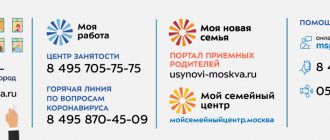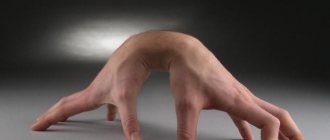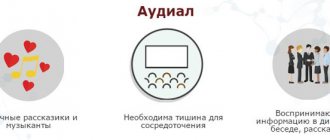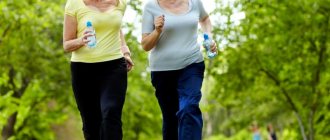Normal blood circulation is important for the heart, all organs and systems without exception. The “components” of the body cannot work properly without the supply of useful substances through the blood and without the timely removal of excess substances - products of metabolic processes, carbon dioxide. Congestion can lead to persistent dysfunction.
The cause of impaired blood circulation is a change in the tone of blood vessels. Their narrowing can occur due to smoking, a sedentary lifestyle, excess weight, diseases of the thyroid and pancreas, kidneys, heart, the development of atherosclerosis, and thrombosis. Insufficient blood circulation in the legs is associated with sedentary work or standing for long periods of time.
Signs of circulation problems
Symptoms of chronic circulatory failure in the brain may not appear until a situation requiring abundant blood supply: stress, unusual physical activity, or being in an unventilated room. They appear suddenly: headache, numbness of part of the face, loss of coordination of movements, tinnitus.
Chronically, the following symptoms may appear: frequent dizziness, decreased memory and performance, poor concentration, drowsiness or insomnia.
Signs of impaired blood flow in the extremities include intermittent claudication (pain when walking and its absence at rest), cold hands and feet in any weather, the formation of spider veins, heaviness, fatigue, swelling, cramps in the leg muscles.
How it works?
The scalp is closely connected to the brain, and therefore the impulses launched during exposure to it quickly penetrate the cerebral cortex and limbic structures, harmonizing the work of the whole body. Speaking about massage and acupuncture, we should not forget about Eastern philosophy, which indicates that the entire person is “permeated” with biologically active points, each of which is responsible for the functioning of specific organs and systems. Moreover, the vast majority of such zones are located on the head.
Scalp massage has been proven to:
- Activates blood circulation and lymph flow.
- Improves nutrition of soft tissues.
- Relieves muscle tension.
- Improves the mood and general condition of the patient.
Similar properties of the procedure are reflected in a person’s appearance: after just a few sessions, complexion and hair condition improve, fine expression wrinkles disappear and the oval of the face is tightened.
Thus, facial massage can be recommended for the treatment of headaches and neurological pathologies, such as insomnia, disease prevention and for rejuvenation.
How to improve blood circulation in your legs
If you do not monitor blood circulation in your legs, you may miss the onset of the development of irreversible disorders. Poor blood flow leads to varicose veins - persistent dilation of veins. In order to ensure normal blood flow and vascular tone, avoid elevators and give preference to walking up the stairs. It is also useful to walk and ride a bicycle/exercise bike.
And these exercises can be done at home every day:
- Get on your knees with your elbows on the floor in front of you. As you exhale, straighten your legs so that your body forms the letter “L”, hold for 10 seconds, return to the starting position.
- Lying on your back, imitate riding a bicycle - arms behind your head, raise your legs perpendicular to your body. 30 rotations, the number of approaches may vary depending on the strength of the muscles.
- In a sitting position, press your heels to the floor, raise your toes, then vice versa. Repeat 20-30 times. Ideal in the evening for those who suffer from calf muscle cramps.
- Lying on your back, lift one leg. Rotate it clockwise 20 times. Repeat with the other leg counterclockwise.
- While sitting, spread your straight legs to the sides as far as stretching allows. Bend alternately in both directions 10 times.
The invaluable benefits of head massage
As was said, people in ancient times valued this procedure very much and knew a lot about its benefits. Main benefits of head massage:
- improving blood circulation;
- improvement of metabolism in tissues;
- activation of the sebaceous and sweat glands;
- beneficial effect on the scalp and hair.
A correctly performed procedure can achieve both therapeutic and cosmetic effects. The therapeutic effect is aimed at eliminating headaches, stress and anxiety, improving sleep quality, and improving mental activity. An experienced specialist will also help normalize blood pressure.
As for the cosmetic side, massage movements significantly improve the condition of the scalp, get rid of dandruff, excessive dryness/oily hair. If you are concerned about hair loss, massage will strengthen the hair roots and stimulate their growth. To achieve maximum effect, you should contact qualified professionals.
It is important to know: all massage movements must be strictly carried out along massage lines, from the top of the head down, since these directions coincide with lymph flow and hair growth.
How to improve cerebral circulation
Chronic cerebrovascular accident is a direct path to stroke. It is fraught with other unpleasant consequences: memory impairment, deterioration in performance, dizziness and fainting, numbness of the face.
Here are 5 exercises to improve cerebral circulation:
- Birch. A universal pose to improve blood flow throughout the body, including the head. You need to start from a minute, gradually increasing the time.
- Tilts in all directions and rotation of the head. Movements should be smooth. Do not overdo it, if your eyes darken or you feel dizzy - reduce the range of movements after a 5-minute break.
- Stand with your back to the wall, inhale and press hard against it, tensing your neck muscles. Hold for 5 seconds, relax.
- While sitting, press your forehead with your palm and tense your neck muscles, not allowing your head position to change. Hold the position of holding your breath for 5-10 seconds, exhale, relax. 4-7 repetitions are enough.
- While sitting at the table, rest your elbow on it. Press your palm to your temple. Tilt your head towards your hand, resist with your palm. Keep the muscles tense for 5-10 seconds, then repeat on the other side.
Self-massage of the cervical-collar area
It helps prevent fatigue, overexertion, pain, and complications after injuries.
Beneficial properties of neck massage
The procedure is aimed at relieving pain and fatigue. It stimulates blood circulation, relieves spasms and relaxes muscles, and improves skin tone. Massage of the cervical-collar area:
- Efficiency increases.
- Memory improves.
- A morning massage helps you invigorate, and an evening session helps you fall asleep faster.
- Blood circulation is stimulated. Tissues receive more oxygen.
- Muscle tissue dystrophy is eliminated.
- Connective tissues are rejuvenated.
- The mobility of the intervertebral disc joints is restored.
- The muscle corset is strengthened.
Osteochondrosis of the cervical spine
In the initial stages of osteochondrosis, neck massage helps speed up recovery. Pain symptoms after injury and with intervertebral hernia are reduced. For osteochondrosis of the cervical spine, self-massage of the neck is considered a useful and effective procedure. It strengthens muscles and improves the condition of cartilage tissue.
In addition to the fact that muscles relax and spasms decrease.
If you apply pressure to the front of the neck, self-massage has a cosmetic effect: the connective tissue is saturated with oxygen and rejuvenated. And, as a result, aging slows down. In addition, the chance of developing a double chin becomes less.
Who needs a massage?
Self-massage of the neck is recommended not only for those who have pathologies, but also for healthy people. Can be used to prevent circulatory disorders and osteochondrosis. It is recommended for those who lead a sedentary lifestyle or have a sedentary job.
Massage is recommended for people experiencing fatigue, overstrain and pain after a hard day at work.
It is also recommended for children, since most of them have various postural disorders. Massage helps relax muscles and relieve spasms.
Indications for massage of the cervical-collar area
Massage is prescribed in the following cases:
- Presence of pain and stiffness.
- Overwork.
- Headache.
- Osteochondrosis.
- Bad mood and insomnia.
Indications also include: a feeling of discomfort in the shoulder area and prolonged physical activity.
Contraindications
Self-massage not only brings benefits, but also has some contraindications. Since the muscles in the neck are not the strongest and have a small layer of fat, a massage can cause harm. There are certain conditions in which this procedure cannot be done. These include:
- Oncology.
- Infectious diseases.
- vertebral instability.
- High blood pressure.
- Injuries.
- Inflammatory processes.
As well as vascular pathologies, for example, atherosclerosis and the presence of purulent processes, burns, wounds.
Rules for performing self-massage
It is necessary to take a comfortable position for the procedure. The best position is sitting on a chair. All movements should be smooth and careful, you should not put pressure on the vertebrae. You need to breathe evenly, without holding your breath. It is recommended to move from top to bottom - this promotes more active movement of lymph. The quality of the result will depend on the correct execution. Muscles relax, tension is relieved, blood circulation and tissue trophism improve.
Implementation principles
It is necessary to remember that you need to move smoothly, but you must not forget to increase the intensity of the pressure. The main thing is that all actions should be without sudden movements or jerks, otherwise there is a risk of damaging the skin and subcutaneous muscles.
- Execution areas: neck and shoulders.
- Movements should go from top to bottom, starting from the hairline and slowly moving down.
- For massage you should use oil or cream. This way your hands glide over the skin more easily and there is no risk of stretching or damaging the skin.
The highest quality procedure is a procedure performed with both hands.
Preparation
Immediately before the procedure, you need to relieve some of the tension from the muscles of the neck and shoulders. To do this, do a simple exercise.
- Pull your head into your shoulders as much as possible.
- Pull them down sharply.
- Repeat the exercise several times.
Technique
Before the massage, the skin needs to be warmed up. You need to slowly stroke the back of the neck and shoulders, moving from top to bottom, along the spine. There is no need to put pressure on the spine itself.
The second stage is rubbing. Using your fingertips, massage the back of the neck along with the collar area and shoulder blades. Light tingling is also acceptable. To soothe the skin, rubbing alternates with stroking.
It is useful to massage the front of the neck and face. The movements are the same as in the back zone, but they should be lighter and softer. Pressing on the lymph nodes and carotid artery should be avoided. Massage of the front area and face improves skin color, removes fine wrinkles and slows down the signs of aging.
Additional accessories
At home, it is recommended to do self-massage with the help of massagers. This way the relaxation will be stronger. At the same time, tension in the muscles of the shoulder girdle is minimal. Some of the most convenient devices for self-massage are electronic massagers.
But cheaper products are no less effective. These include various wheels with needles, balls, and sticks. Massage therapists recommend buying massagers made from natural materials - wood or minerals. Roller massagers have proven themselves to be the most effective.
To achieve the best effect, it is recommended to regularly perform self-massage sessions.
Author: K.M.N., Academician of the Russian Academy of Medical Sciences M.A. Bobyr
When to see a doctor immediately
Symptoms of acute cerebrovascular accident are a reason to call an ambulance:
- asymmetry of the face, tongue;
- numbness, weakness, paralysis of a limb;
- speech disorders;
- double vision, loss of focus;
- vomit;
- severe incoordination of movements (“drunk” gait);
- confusion;
- unusually severe headache.
Medical care is also needed when the symptoms of a chronic circulatory disorder do not go away for a long time, and exercises do not help restore vascular tone. If severe dizziness, headache, drowsiness, difficulty concentrating, or fatigue persist for several days, consult a physician or neurologist.
Some signs of poor circulation in the legs also require medical attention. Spider veins, bulging veins, long-lasting bruises, persistent cramps in the calf muscles are a reason to visit a phlebologist.
Massage techniques and techniques
Acupressure
Acupressure is stimulating energy centers or points with your fingers. This technique is simple, and you can master it even at home. You should familiarize yourself with the location of reflex points using a special atlas. Their size varies depending on the state of the person: during sleep, the diameter of the point is 1 mm, and during wakefulness it increases to 1 cm.
When pressing on the point, a person may experience pain or tingling, slight numbness, or a feeling of warmth.
The massage technique includes the following techniques:
- Pressure, the strength of which increases gradually;
- Stroking;
- Kneading;
- Rotational movements.
The duration of exposure to each point is up to a minute. For greater effectiveness, alternate circular movements with moderate pressure for 5 seconds. Symmetrical points must be massaged simultaneously.
To eliminate headaches, use points located:
- In the temporal fossa;
- Above the outer edge of the eyebrows;
- At the outer corner of the eyes;
- In the hollow between the bridge of the nose and the inner corner of the eyes;
- On the front of the auricle at the top of the recess of the ear tragus;
- On the temporal bone, above the top of the auricle.
The impact should be careful and with little pressure - otherwise the formation of bruises and bruises cannot be avoided.
Massage to strengthen memory
To improve blood circulation in the brain, massage the point located in the center of the line running from the frontal part of the head to the neck. The second point for impact lies just above the upper lip. Massaging should be done with intense pressure using the pad of the thumb or index finger. Processing time is from 30 seconds to 1 minute. You can repeat it several times a day.
What is the lymphatic system
The human body is penetrated by lymphatic vessels. Unlike blood, lymph is completely colorless and contains fewer proteins and nutrients. Its tasks are different - to remove toxins from tissues along with liquid. Another important function is the delivery of lymphocytes and macrophages to areas affected by infections and bacteria.
Dysfunction of the lymphatic system can lead to such a dangerous disease as lymphostasis. There can be many reasons, but the main ones are:
- chronic fatigue and stress;
- poor nutrition;
- low physical activity.
Insufficient movement of lymph through the vessels causes stagnation of intercellular fluid. This dysfunction is partially compensated by the kidneys and blood circulation, but toxins accumulate, and this affects health and attractiveness. The following signs indicate the appearance of lymph flow disorders:
- varicose veins;
- high blood pressure;
- swelling;
- excess weight;
- circles under the eyes;
- pronounced cellulite;
- decreased protective functions of the body.
What parts of the body does lymphatic drainage affect?
Stagnation phenomena can be observed in different areas. The problem mainly affects the legs, and a little less often the face. Therefore, lymphatic drainage is usually performed in these areas.
Face massage
A facial massage session will be effective in eliminating the following shortcomings:
- postoperative scars;
- loss of skin elasticity;
- swelling;
- acne;
- a large number of wrinkles, facial creases.
This modern procedure is not uncommon in beauty salons, but you need to trust your face to an experienced specialist. Usually the first results are noticeable after the end of the session due to the removal of swelling and improvement of complexion. It is better to refrain from lymphatic drainage if there are inflammatory processes on the face or neurological diseases.
Body massage
Lymphatic drainage can be used to shape the figure or correct aesthetic skin imperfections. In particular, massage helps rid the skin of cellulite. In addition, by increasing the activity of the lymphatic system, swelling in the legs is relieved, and the silhouette becomes more toned. The most popular is foot massage, which is performed in combination or separately.
Lymphatic drainage massage - the essence of the procedure
During a lymphatic drainage session, the massage therapist uses special techniques that prevent lymph from stagnating in the vessels. Its more intense outflow helps remove toxins along with excess fluid.
A necessary condition for effective massage is the experience of a specialist. He must know the principles of the structure and operation of the lymphatic system. The specialist performs all movements strictly from bottom to top in accordance with the movement of lymph in the vessels. A gentle mechanical effect activates the movement of lymph, which reduces swelling.
Usually during the session there are no unpleasant or painful sensations, as gentle techniques are used. The doctor acts gently and smoothly, and the intensity increases gradually.
Pronounced results can only be achieved by a course of several procedures. Usually no more than 10 sessions are required, which are scheduled every other day.
Improving blood circulation in the brain - vitamins
Among the vitamins for improving blood circulation in the brain, one can highlight Vitamin B5 (pantothenic acid), which is necessary for the functioning of nerve fibers, the division of epithelial cells and the formation of the inner wall of blood vessels. Vitamin B6 (pyridoxine) is involved in the functioning of the nervous system, is necessary for the formation of a number of neurotransmitters, and reduces the level of lipids in the blood. Vitamin B8 (inositol) is part of the protective membrane of brain cells, stabilizes lipid metabolism, and normalizes mood.
Vitamin C (ascorbic acid) normalizes blood clotting, stabilizing blood flow, stabilizes capillary permeability, and is an antioxidant. Also, complexes with minerals - phosphorus, magnesium, selenium and zinc - are useful to improve blood circulation in the brain. All these minerals are necessary to maintain the functioning of brain cells. Examples of such complexes are Magnesium + Vitamin B6, Zinc + Vitamin B6, Multivitamin complex 360.









